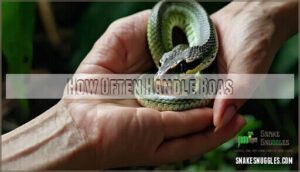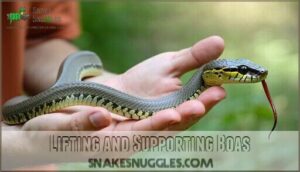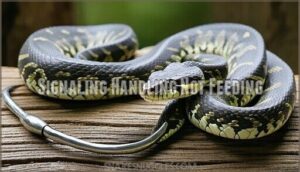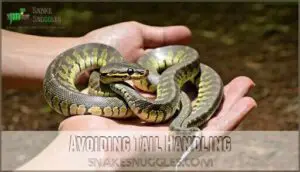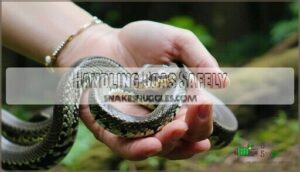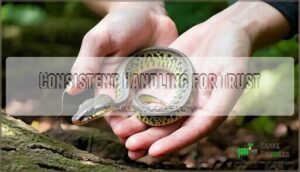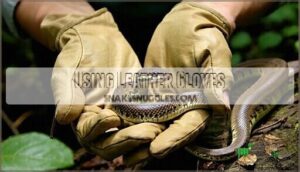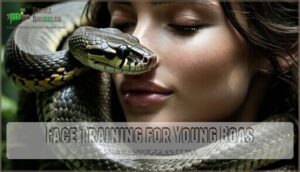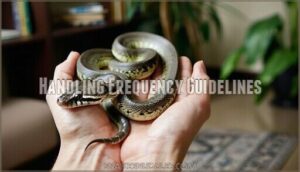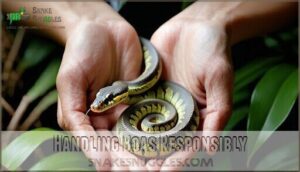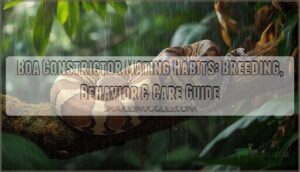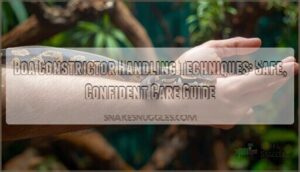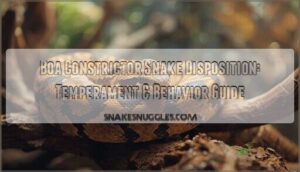This site is supported by our readers. We may earn a commission, at no cost to you, if you purchase through links.
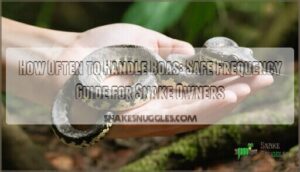
Your boa’s age, size, and temperament determine the ideal frequency. Young boas need consistent handling to build trust, while large adults require less frequent sessions.
Always avoid handling for 48-72 hours after feeding to prevent regurgitation. Watch for signs your snake isn’t in the mood—defensive posturing, hissing, or pre-shed behavior means it’s hands-off time.
Start with 10-15 minute sessions and gradually increase as your boa becomes comfortable. Understanding your snake’s unique personality and body language makes all the difference in creating a positive handling experience.
Table Of Contents
- Key Takeaways
- Handling Boa Constrictors
- How Often Handle Boas
- Boa Handling Techniques
- Handling Boas Safely
- Boa Constrictor Behavior
- Handling Young Boas
- Adult Boa Handling
- Handling Frequency Guidelines
- Post-Handling Care
- Handling Boas Responsibly
- Frequently Asked Questions (FAQs)
- Do boas like to be handled?
- Should I handle my ball python everyday?
- How often should I handle my snake?
- How often should I handle my sand boa?
- Can I handle my boa during shedding?
- How long after feeding before handling?
- What if my boa wont stop wrapping?
- Should I handle sick or injured boas?
- Can children safely handle boa constrictors?
- Conclusion
Key Takeaways
- You should handle your boa 1-2 times per week, with younger snakes needing slightly more frequent interaction to build trust and reduce defensive behavior.
- Never handle your boa within 48-72 hours after feeding to prevent regurgitation, and avoid handling during pre-shed periods when they show cloudy eyes or defensive posturing.
- Start with short 10-15 minute sessions and gradually increase duration as your boa becomes comfortable, always supporting their body weight properly and using gentle movements.
- Adult boas over 6 feet require a second person present for safety, and you’ll need to read your snake’s body language to recognize stress signals like hissing, coiling, or striking postures.
Handling Boa Constrictors
Handling your boa constrictor properly is essential for building trust and ensuring both your safety and the snake’s well-being.
With the right approach, you can develop a peaceful relationship with your boa through gentle, consistent interaction.
Importance of Gentle Handling
Gentle handling forms the foundation of safe boa constrictor care.
Trust grows through gentle touch and patient consistency with your boa constrictor.
Your approach directly impacts your snake’s stress levels and overall well-being.
Proper handling boa constrictors requires patience and consistency to establish positive interactions.
Key principles for safe boa handling include:
- Reducing Stress through calm, deliberate movements
- Building Trust with consistent, gentle contact
- Preventing Injury by supporting the snake’s body weight
- Promoting Calmness through predictable handling routines
Mastering boa handling tips guarantees both handler and snake remain comfortable during interactions.
Building Trust With Boas
Building trust with your boa requires gentle interaction and positive reinforcement during every handling session.
Consistent routine helps establish recognizing signals between you and your snake. Start with brief, calm sessions to build confidence gradually.
Your boa’s temperament handling improves through regular, patient contact. These handling practices create a foundation where your snake associates your presence with safety, making future boa handling frequency decisions easier and more successful, based on positive reinforcement.
Recognizing Owner Interaction
Boa recognition develops through consistent interaction patterns.
Your snake learns your scent, voice, and gentle movements over time.
Patient interaction creates lasting bonds that make handling sessions more peaceful and predictable.
Signs your boa recognizes you include:
- Calm body language when you approach the enclosure
- Reduced defensive posturing during regular handling sessions
- Slower, more relaxed movements in your presence
- Less frequent hissing compared to interactions with strangers
Trust development requires regular boa handling frequency of 2-3 times weekly.
This boa interaction frequency helps establish familiarity without causing stress.
How Often Handle Boas
When determining your boa handling schedule, you’ll need to balance frequency with your snake’s temperament and natural rhythms. New owners often wonder how often to handle their boa without causing stress or disrupting important biological processes like the shedding cycle.
Start with brief sessions twice weekly for new boas, allowing proper acclimation to their environment. Your owner schedule should accommodate this gradual approach, as rushing the process increases bite risk and creates defensive behaviors. Remember to always wash your hands before handling to remove any scents.
Here’s your boa handling guide for ideal frequency:
- Initial period: Handle 2-3 times weekly for 5-10 minutes maximum
- After one month: Increase handling duration to 10-15 minutes per session
- Adult boas: Maintain 1-2 sessions weekly to preserve tameness
- Temperament impact: Adjust frequency based on individual snake’s comfort level
The best time to handle your boa is when it’s alert but calm, avoiding feeding days and pre-shed periods. Your boa handling frequency should reflect consistent, positive interactions rather than daily marathons that stress both you and your snake.
Boa Handling Techniques
Proper technique matters when you handle your boa constrictor, as it keeps both you and your snake safe during interactions.
You’ll need to master specific methods for lifting, supporting, and signaling to guarantee stress-free handling sessions.
Lifting and Supporting Boas
Use a snake hook to lift your boa initially, then support its body with both hands.
Never grab the tail – this causes severe spinal damage. Support the body weight evenly to prevent injury. Maintain a secure grip while allowing natural movement.
| Technique | Correct Method | Avoid |
|---|---|---|
| Initial Lift | Use snake hook first | Grabbing directly |
| Body Support | Both hands, even weight | Single-hand lifting |
| Grip Position | Behind head, mid-body | Tail or neck only |
| Movement | Allow natural flow | Restricting motion |
Signaling Handling Not Feeding
Before handling your boa, always tap it gently on the head with a paper towel roll or snake hook.
This tapping signals handling time, not feeding time, preventing your snake from confusing your hand with food.
Consistent signals through snake hook use help establish clear communication patterns with your boa.
A handler might consider purchasing a hook for safety.
This simple reinforcement learning technique reduces bite risks and creates predictable boa handling techniques that respect your snake’s temperament handling needs.
Avoiding Tail Handling
Never grab a boa by its tail—this common mistake causes severe spinal damage and unnecessary stress.
Your snake’s tail can’t support its full body weight, making proper grip strength essential for safe handling.
Here’s why tail sensitivity matters:
- Spinal damage occurs when vertebrae compress under the snake’s weight
- Supporting weight requires distributing pressure across the body
- Injury prevention means using both hands to cradle the snake
- Boa temperament handling improves when you avoid painful mistakes
- Handling stressed boa becomes easier with proper techniques
Always support your boa’s body completely during handling sessions.
Handling Boas Safely
Safe boa handling requires proper preparation and technique to protect both you and your snake.
You’ll need to wash your hands before contact, use appropriate tools like snake hooks, and move slowly to avoid startling your boa.
This approach ensures safe handling for both the handler and the animal, promoting a healthy and respectful interaction.
Washing Hands Before Handling
Clean hands before handling removes food scents and pathogens that could stress your boa. Scent Removal prevents confusion during boa handling duration, while Pathogen Prevention protects both you and your snake.
Proper hygiene before handling prevents food confusion and protects both snake and handler from harmful pathogens.
Consistent Scent through proper Hygiene Importance builds trust over multiple sessions.
| Why Clean Hands | What to Remove | Best Practice |
|---|---|---|
| Prevents food confusion | Food odors | Soap and water wash |
| Reduces disease risk | Bacteria/germs | Hand sanitizer follow-up |
| Maintains consistent scent | Other animal smells | Change clothes if needed |
| Builds handling trust | Potential pathogens | Clean before every session |
Using effective hand-cleaning products is vital for this step.
Disease Control through proper handling guidelines guarantees safe boa snake handling every time.
Using Snake Hooks
Why struggle with direct hand contact when snake hooks provide safer boa snake handling? These essential tools create distance between you and your boa while demonstrating proper handling techniques.
Snake Hook Essentials:
- Hook Material – Choose sturdy metal or high-quality plastic that won’t bend under your boa’s weight
- Hook Size – Select 24-36 inch hooks for adult boas to maintain safe distance during lifting technique
- Signaling Method – Gently tap your boa’s head before lifting to indicate handling, not feeding time
- Lifting Technique – Use the hook to initially lift, then shift to two-handed body support
- Avoiding Injury – Never use hooks to pin or restrain; they’re lifting tools that prevent defensive strikes
These handling guidelines guarantee both you and your boa stay safe during interactions. Remember to watch for signs of stress, such as tight coiling behavior, during handling.
Avoiding Sudden Movements
Sudden movements trigger your boa’s defensive instincts, turning calm handling into a stressful encounter.
Move slowly and deliberately when handling baby boa or during adult boa handling sessions.
Predictable movements promote boa safety and stress reduction, while jerky motions increase signs of stress boa display.
Proper boa handling requires steady confidence—your calm approach prevents injury prevention concerns and guarantees successful interactions, ensuring a positive experience with your calm approach.
Boa Constrictor Behavior
Understanding your boa’s behavior helps you determine when handling is appropriate and safe.
You’ll need to recognize signs like defensive posturing, pre-shedding indicators, and stress signals to avoid handling during vulnerable periods.
Recognizing Defensive Behavior
Defensive boa behavior involves unmistakable warning signals that protect both you and your snake.
Hissing loudly, coiling into defensive postures, and displaying striking signs indicate stress levels requiring immediate attention.
Adult boa handling demands recognizing these cues before attempting contact.
Watch for flattened body positions and rapid tongue-flicking when approaching your enclosure.
Proper boa handling means respecting these boundaries to avoid bites and reduce stress.
Understanding Pre-Shedding Behavior
When your boa enters pre-shedding mode, you’ll notice distinct shedding signs that signal handling precautions are necessary.
Blue phase marks the beginning, where your snake’s eyes turn cloudy and behavior changes become apparent.
- Skin dullness appears as colors fade and patterns blur
- Irritability increase makes your boa more defensive than usual
- Hiding behavior intensifies as they seek dark, secure spaces
- Sagging skin indicates the old layer is loosening and ready to shed
- Blue phase creates temporary vision impairment affecting their comfort
Reduce handling frequency during this period to maintain boa health and prevent stress-related complications.
A suitable enclosure should mimic their natural habitat to reduce stress.
Monitoring Body Language
Reading your boa’s body language prevents dangerous encounters and guarantees safe handling sessions. Watch for key defensive postures and stress signals before attempting contact.
| Body Language Signal | What It Means | Your Response |
|---|---|---|
| Coiled with raised head | Defensive posture, ready to strike | Wait, don’t handle |
| Hissing with open mouth | Stressed, feeling threatened | Give space, try later |
| Loose, relaxed posture | Handling readiness, calm state | Safe to handle |
| Tight S-curve shape | Preparing to strike | Avoid contact completely |
| Slow, deliberate movement | Comfortable, exploring | Continue gentle handling |
Snake behavior includes facial expressions and tail movement patterns that reveal their comfort level. Understanding these stress signals helps you determine proper handling frequency and timing for your boa constrictor.
Handling Young Boas
Young boas need consistent handling to reduce nippiness and build trust with their owners.
You can start handling them for short periods every few days, gradually increasing the duration as they become more comfortable with human interaction.
Consistent Handling for Trust
Young boa constrictors require patient, consistent handling to build trust over time. Start with brief 5-minute sessions every few days, gradually increasing to 10-15 minutes as your snake becomes comfortable.
Regular handling can also help boas become more tame, but avoid over handling to minimize stress.
Building Boa Bonds through consistent snake handling:
- Handle 1-2 times weekly – Regular interaction without overwhelming your boa constrictor
- Start after one week – Allow acclimation before initial handling sessions
- Monitor snake behavior – Watch for stress signs during each interaction
- Increase Handling Duration gradually – Brief sessions prevent snake stress while Recognizing Individuals
- Use Positive Reinforcement – Gentle snake handling techniques build lasting trust
Using Leather Gloves
When juvenile boas display defensive behavior, leather gloves provide essential bite protection during handling sessions.
Quality glove material guarantees handling confidence while reducing nippiness concerns. Many owners find protective hand coverings particularly useful.
| Glove Consideration | Recommendation |
|---|---|
| Glove Thickness | Medium-weight leather for flexibility |
| Glove Material | Genuine leather or synthetic alternatives |
| Bite Protection | Covers fingers and palm completely |
| Handling Techniques | Maintain gentle, supportive grip |
| Handling Precautions | Remove after snake shows calmness |
Face Training for Young Boas
Training your boa constrictor’s face helps create positive associations during handling sessions.
This practice teaches young boas that human faces aren’t threats, reducing defensive strikes over time.
- Allow exploration: Let your boa investigate your face, hair, and glasses naturally
- Watch for tension: Monitor body language and interrupt if strike signs appear
- Keep sessions brief: Limit face training to short, controlled interactions
- Build trust gradually: Start with distant exposure before closer contact
- Practice patience: Young boas need time to recognize safe interaction practices
Adult Boa Handling
When you handle adult boas, you need to approach them with more caution than juveniles since their size and strength require respect.
Adult boas should be handled carefully until you understand their individual personality, and any boa over 6 feet long requires a second person present for safety.
Cautious Handling for Large Boas
Large adult boas require handling assistance due to their considerable strength.
You’ll need adult supervision when handling boa constrictors over six feet—their muscle power demands experience and bite risk awareness. Always use two-person handling techniques for safety.
These handling precautions understanding prevents accidents. Tap training methods can help reduce defensive behaviors.
Never handle alone; their strength requirements make handling assistance essential for both handler and snake safety.
Respecting Boa Boundaries
After learning safe handling tips for large boas, it’s time to focus on respecting each boa constrictor’s boundaries.
Reading body language is key—watch for signs like heavy breathing or rapid tongue flicking.
Recognizing stress signals helps you avoid overhandling and negative interactions.
Each snake has its own temperament, so adjust your snake handling advice and handling preferences to match their comfort.
Handling Boas Over 6 Feet
When your boa constrictor reaches six feet, you’ll need partner assistance for safe handling.
These powerful snakes require strength requirements that exceed solo handling capabilities. Use proper safe lifting techniques with one person supporting the head and another the body.
Watch for temperament changes as large boas can become more defensive. Verify adequate enclosure size prevents escape during handling sessions.
Handling Frequency Guidelines
Getting the frequency right matters more than you might think in the case of handling your boa constrictor.
Start with short sessions and build up gradually to create a stress-free experience for both you and your snake.
Initial Handling Duration
When you first bring home your boa constrictor, patience during the first week sets the foundation for successful taming.
Short sessions help your snake adjust without overwhelming stress.
- Keep initial handling to 5 minutes maximum
- Handle only 1-2 times during first week
- Wait until your boa eats regularly before starting
- Monitor for defensive behaviors like hissing or coiling
Building confidence through proper handling frequency creates owner comfort and snake trust.
Gradually Increasing Handling Time
After your boa shows comfort during initial sessions, extend handling duration gradually from five minutes to 10-15 minutes.
This steady progression helps build confidence and prevents overwhelming your snake.
Watch for positive boa signals like relaxed movement and calm exploration.
Consistent session frequency combined with proper handling techniques supports effective taming and deeper understanding of your boa constrictor’s comfort levels.
Handling Frequency for Adult Boas
Most adult boas thrive with handling once or twice weekly, though some tolerate daily 10-15 minute sessions without stress.
Your boa’s temperament considerations and individual differences determine ideal snake handling frequency.
During breeding cycles and seasonal variations, adjust handling duration accordingly.
Monitor your boa constrictor’s body language closely—defensive behaviors signal you’re overdoing it.
Understanding snake handling techniques helps you recognize when your pet needs less interaction versus more socialization time.
Post-Handling Care
After handling your boa, you’ll need to complete essential hygiene tasks to keep both you and your snake healthy.
Clean the enclosure weekly and wash your hands thoroughly to prevent salmonella transmission and other potential health risks, ensuring you follow proper hygiene to maintain a safe environment.
Cleaning Enclosures
Maintaining a spotless snake enclosure requires consistent attention to detail and the right approach.
Your boa’s health depends on proper enclosure maintenance, so establishing a weekly cleaning routine becomes essential for odor control and waste removal.
Follow these three key steps for effective enclosure cleaning:
- Remove all substrate and visible waste using appropriate tools
- Apply disinfectant options like 3% bleach solution to all surfaces
- Replace with fresh substrate choices that support your boa’s comfort
Regular enclosure maintenance prevents bacterial buildup and creates a healthier environment for your snake.
Washing Hands After Handling
Proper hygiene practices protect both you and your family from harmful bacteria like salmonella.
Always wash your hands thoroughly with soap and warm water immediately after handling your boa.
This simple step prevents zoonotic diseases from spreading throughout your household.
For additional safety, consider snake handling best practices to minimize risks.
Scrub for at least twenty seconds to guarantee effective bacteria removal and disease control.
Preventing Disease Transmission
Beyond proper handwashing, you’ll need to protect yourself from zoonotic diseases that snakes can carry.
Salmonella prevention requires strict hygiene protocols after every handling session.
Quarantine procedures help identify sick boas before bacteria or viruses spread, and regular parasite control and cleaning your boa’s enclosure reduces disease transmission risks substantially, through strict hygiene protocols.
Handling Boas Responsibly
Responsible boa handling means respecting your snake’s needs and your own safety limits.
You’ll build the strongest bond by following proper timing guidelines and avoiding situations that could stress your boa or reinforce unwanted behaviors.
Avoiding Handling After Feeding
Never handle your boa within 48 hours after feeding.
This timing prevents regurgitation risk and digestion interruption, which can stress your snake and waste valuable nutrients.
Your boa needs uninterrupted time to process its meal properly, and sticking to your feeding schedule is crucial.
Plan safe handling sessions accordingly, as this simple rule protects your snake’s health and reduces unnecessary stress during the critical digestion period.
Not Reinforcing Negative Behavior
If your boa shows defensive behavior like hissing or biting, don’t immediately return it to its enclosure. This teaches the snake that aggression works to avoid handling.
Instead, maintain calm control and use these strategies:
- Stay still until your boa relaxes, showing consistent signals that you’re not a threat
- Redirect nervous energy through gentle movement rather than avoiding all handling
- Reward calm behavior with shorter, positive sessions to encourage behavior modification
Proper bite response involves staying composed while your snake learns that biting doesn’t end interactions. This positive reinforcement approach reduces future aggression and builds trust over time.
Seeking Veterinary Advice
Regular veterinary checkups help you catch health issues before they become serious problems.
Your boa needs annual veterinary checkups with a reptile specialist who understands snake health.
Watch for warning signs like cloudy eyes, unusual lumps, or lethargy that require immediate attention.
| When to Seek Care | Signs to Watch For |
|---|---|
| Annual Check-ups | Routine health assessment |
| Emergency Situations | Difficulty breathing, seizures |
| Recognizing Illness | Loss of appetite, unusual behavior |
| Preventative Care | Parasite screening, weight monitoring |
| Specialist Referrals | Complex medical conditions |
Frequently Asked Questions (FAQs)
Do boas like to be handled?
Boas aren’t naturally affectionate pets, but they can recognize you and become peaceful when handled regularly. They won’t seek cuddles, yet gentle, patient handling builds trust over time.
Should I handle my ball python everyday?
While daily interaction sounds appealing, you shouldn’t handle your ball python every day. Handle every 3-4 days for 10-15 minutes maximum to avoid stress and maintain your snake’s health.
How often should I handle my snake?
Handle your snake every few days for 5-10 minutes initially, then gradually increase frequency. Avoid handling during shedding, feeding days, or within 48 hours after meals to prevent stress.
How often should I handle my sand boa?
You should handle your sand boa every few days for 5-10 minutes once it’s settled in.
Start slowly, avoid handling during shedding or after feeding, and gradually increase frequency as trust develops.
Can I handle my boa during shedding?
Should you disturb a snake mid-molt? Absolutely not!
Don’t handle your boa during shedding—their skin’s delicate and vision’s cloudy.
Wait until they’ve completely finished shedding before resuming regular handling sessions, as this is crucial for the snake’s well-being, and absolutely ensures a safe environment.
How long after feeding before handling?
Wait at least 48 hours after your boa’s last meal before handling.
This prevents regurgitation and digestive stress.
Your snake needs time to properly digest its food before any physical interaction or movement.
What if my boa wont stop wrapping?
When your boa wraps around you, stay calm and don’t pull away.
It’s natural behavior for stability.
Gently support its body and slowly unwrap from the tail end forward, moving patiently without forcing it.
Should I handle sick or injured boas?
Skip handling sick or injured boas completely. You’ll stress them further and potentially worsen their condition. Instead, minimize disturbances and contact a reptile veterinarian immediately for proper treatment guidance.
Can children safely handle boa constrictors?
Children can safely handle small, calm boa constrictors with proper adult supervision. You’ll need to teach proper support techniques and watch for defensive behaviors like hissing or coiling.
Conclusion
Like a well-tuned instrument, knowing how often to handle boas creates harmony between you and your snake.
Regular handling sessions build trust and strengthen your bond, but timing matters.
You’ll find that 1-2 weekly sessions work best for most boas, with younger snakes needing slightly more interaction.
Remember to avoid handling after feeding and watch for stress signals.
Your boa’s comfort level should guide your approach, making each interaction positive and rewarding for both of you.
- https://www.reptifiles.com/snake-bite-strike-constricting/
- https://findyourreptile.com/reptile-info/boa-imperator-articles/beginners-guide-to-boa-constrictor-care/
- https://reptifiles.com/boa-constrictor-care/boa-constrictor-handling/
- https://www.knobcreeknaturalist.com/blog/handling-your-boa-constrictor
- https://allaboutboas.com/en/faq/how-do-i-handle-a-boa-constrictor-safely.html

